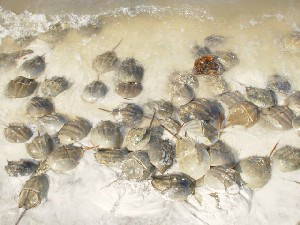FWC Seeks Help In Surveying Spawning Horseshoe Crabs
By FWC // March 16, 2015
TALLAHASSEE, FLORIDA — As spring approaches, horseshoe crabs congregate to spawn along sandy beaches and shallow coastal waters throughout the state.

Florida Fish and Wildlife Conservation Commission (FWC) biologists are asking the public to assist in the FWC’s survey effort by reporting horseshoe crab sightings and other useful information.
Although horseshoe crabs mate year-round, spring is the peak season to see them aggregate on beaches and in bays. Citizen scientists interested in contributing to the survey should have the best luck sighting horseshoe crabs around high tide within three days of a new or full moon, March 20 and April 4 respectively.
The FWC asks people to report sightings by using the online form listed under “Horseshoe Crab Nesting Activity” by going to MyFWC.com/Contact. You can also email findings tohorseshoe@MyFWC.com or call the FWC at 866-252-9326.
Observers should note the number of horseshoe crabs they see and whether those horseshoe crabs are mating. Mating crabs “pair up,” with the smaller male on top of the larger female. Other male crabs may be present around the mating pair. If possible, the observer should specify roughly how many horseshoe crabs are mating adults and how many are juveniles (4 inches wide or smaller). Biologists are also interested in the date, time and location of your sighting as well as the habitat type.
Through Dec. 31, 2014, the FWC has received 3,097 reports since the survey program began in April 2002.
Although horseshoe crabs have been around for approximately 450 million years, their populations have declined in recent decades due to overfishing and loss of habitat. It takes female horseshoe crabs about 10 years to reach sexual maturity before they are able to lay about 80,000 eggs per year. The eggs are an important food source for migrating shorebirds, and larger crabs are often consumed by loggerhead sea turtles.
The FWC is grateful when people report sightings.
If you see a horseshoe crab on its back, gently pick it up (holding both sides of the shell) and release it back into the water. Simple actions like this help conserve the species and the countless other species that depend on it.











